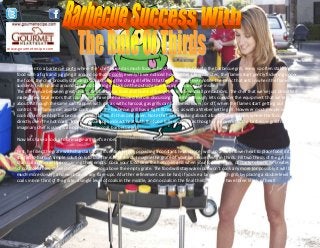
Barbecue succes with the rule of thirds
- 1. Ever been to a barbecue party where the 'chef' placed as much food as he could possibly fit onto the barbecue grill, every so often stabbing the food with a fork and juggling it around so that it cooks evenly? Ever noticed how, within a few minutes, the flames start gently flickering under the food, the chef proudly standing back admiring the char grill effect that he's creating? Ever notice the panic that sets in when the flames suddenly leap up and around the food burning it black on the outside and leaving it raw on the inside? The difference between great char grilled barbecue food and burnt offerings lies in a few small precautions. The chef that we've just described made a few fatal errors that could easily have been avoided. Before discussing the errors though, lets consider the equipment that we're talking about. Although the same can happen with gas as with charcoal, gas grills can be turned lower, or off, when the flames start getting out of control. The flames can also be controlled if the barbecue grill has a tight fitting lid, as with a Weber kettle grill. However most people seem to cook on an open top barbecue grill with the lid, if it has one, open. Note that we're talking about a barbecue grill here, where the food is cooked directly over the hot coals. True barbecue uses indirect heat with the food fully enclosed as though in an oven. So, the barbecue grill that our imaginary chef is using is an open top, charcoal, barbecue grill. Now lets have a look at our imaginary chef's errors. First, he filled the grate with charcoal along its entire length, providing a constant heat source, with no area of lower heat to place food if it started to burn. A simple solution is to use the rule of thirds. Imagine the grate of your barbecue being in thirds. Fill two thirds of the grill with charcoal and leave the remaining third empty. Cook your food over the hot coals and when your food is ready, or starts to burn, or creates out of control flames, move it over to the section above the empty grate. The food will stay warm but won't cook any more (or possibly it will but much more slowly), and wont cause any flare-ups. A further refinement can be had, if you've a large enough grill, by placing a double level of coals in one third of the grate, a single level of coals in the middle, and no coals in the final third. You now have three levels of heat! www.gourmetrecipe.com
